Once upon a time electrical energy meters had one counter. This counter was direct linked to the consumed energy. The monthly invoice was issued based on the reading difference between last month and actual month (plus eventually some service charges).
The rate per unit was fixed by the utility based on their expenses for power generation or purchase.
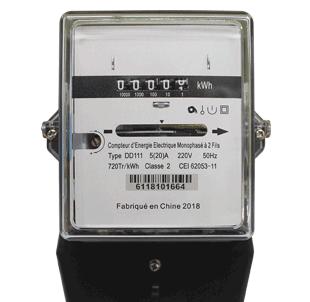
Advanced electromechanical meters had two counters (day/night tariff).
The counter incrementation was switched at a certain time, either by an external clock or by a ripple control (low frequency power line signal). The night rate per unit was typically cheaper.
So the customer was knowing that he saves some cost by using certain appliances during the night (e.g. boiler, washing machine).
The utility benefit was to reduce the consumption during day-time and to have a better control for the power generation.
Then we got electronic energy meters
This meters are still recording the actual power over a certain time. But the microprocessor inside of these meters allows all kind of additional registers and calculation methods. So the utilities are introducing various tariffs and structures.
If your generated power is always matching with the consumed power it's from operative grid management not necessary to introduce tariffs.
Some tariffs explained
Note that this is a very brief overview, you as end customer need to check with your power supplier. All diagrams in this post are qualitative. Given values are for example. The target audience is power companies, utilities and energy distributers.
Single Rate Tariff
The price per unit is all the time the same. (Except there is a utility price update.)
Time of use (TOU) tariff structure
The power provider offers cheaper electricity at times when there is a lower demand (off peak) on the grid. Basically different unit rates are charged for the electricity at different times of the day. So far so good.
But don't underestimate the complexity of the complete TOU structure. You have to deal with days, weekends, seasons, special days…
Without a supporting AMI system it's not possible to handle TOU tariffs in a proper way.
Take a look on the TOU tariff structure here.
The utility benefits are clear. Based on the actual availability of power the tariff changes. It's a good method to let the customers benefit from eventually overproduction.
But it's hard to explain this tariff to your customers.
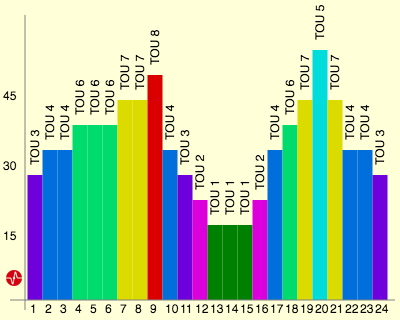
The above diagram shows the hours of the day in x-axes and the price per kWh in y-axes. Defined are eight TOU tariffs (15 cent to 50 cent, in 5 cent steps).
The power company has a solar power plant, so there is a sink during the day, but you saw this already.
The key question is: How to explain this tariff to the end user? Cost per unit is frequently changing.
Actually the above diagram is only valid for every second Thursday in Summer, except weekends and religious holidays. (You see the problem in teaching your customer?)
Practically no one will do this, but it's possible with the time of use tariff.
Step Tariff
The price per unit is step-wise increasing with the consumed units. The example shows a step tariff with three steps. At the beginning of each billing period the customer will start with 0 kWh on the register. The billing period for step tariff is usually end of the month.
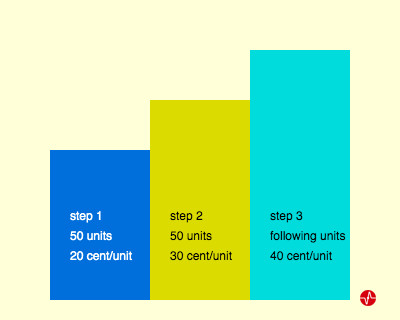
By using a step tariff the utility is able to reduce the total required energy. The customer is adapting his consumption due to the cost.
Block Tariff
The price per unit is block-wise decreasing with the consumed units. The example shows a block tariff with three blocks. At the beginning of each billing period the customer will start with 0 kWh on the register. The billing period for block tariff is usually end of the month.
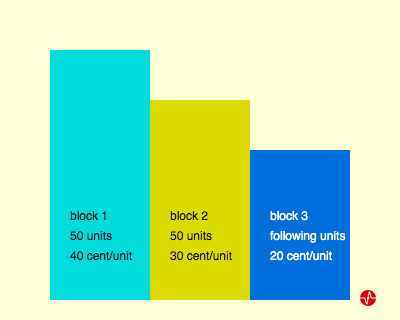
The advantage of a block tariff is that the utility covers the initial energy providing cost with the first blocks.
Demand Tariff
A demand tariff applies mainly to industrial customer. The invoice can consist of several parts:
– the consumption per month in kWh
– the cost per kW according to the maximum demand register
Most utilities provide a table with different demand cost for different power ranges
– a penalty for excess use of reactive energy (kvarh)
Green Tariff
This tariff has nothing to do with metering, it has promotional character. When a utility can proof that a certain amount of energy is produced by renewable energy, it might offer such tariffs.
You miss the explanation for a certain tariff? Ask your power company or drop for general questions a comment in the field below.
Thank you for reading.
Editor's note: This article was originally published in December 2019 and has been updated for comprehensiveness.
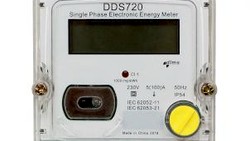

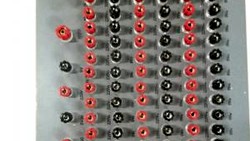
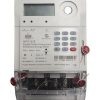
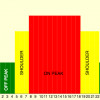
Hello,
I have Single Phase Meter CL710K22
What indicates 1.8.2 and 1.8.3 on the display?
Thank you!
Hi Harry, thanks for your comment. Meter displays 1.8.2 and 1.8.3, means total forward active energy tariff 2 and total forward active energy tariff 3 respectively.
Thanks. I will find out if this tariff is permitted, I mean single phases.
For three phases we only have KWh same all days of year, but Demand in KW ( period of 15 minutes) have period of winter where is too expensive from 6 PM to 11 PM. Have no GPS, only regular clocks, so time is moving all time long.
I think AMI is a real solution for our markets.
Thanks for sharing, Mariano. AMI will for sure bring benefits.